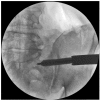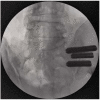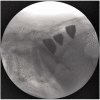Sacroiliac Joint Arthrodesis-MIS Technique with Titanium Implants: Report of the First 50 Patients and Outcomes
- PMID: 23284593
- PMCID: PMC3529399
- DOI: 10.2174/1874325001206010495
Sacroiliac Joint Arthrodesis-MIS Technique with Titanium Implants: Report of the First 50 Patients and Outcomes
Abstract
This retrospective study of 50 consecutive patients treated by a single orthopedic spine surgeon in private practice was conducted to evaluate the safety and efficacy of minimally invasive sacroiliac joint fusion using a series of triangular, porous plasma spray coated titanium implants.Medical charts were reviewed for perioperative metrics, complications, pain, quality of life and satisfaction with surgery. All patients were contacted at a 24 months post-op to assess SI joint pain, satisfaction with surgery and work status.An early and sustained statistically significant improvement in pain function was identified at all post-operative time points (ANOVA, p<0.000). A clinically significant improvement (>2 point change from baseline) was observed in 7 out of 9 domains of daily living. The complication rate was low and more than 80% of patients would have the same surgery again.MIS SI joint fusion appears to be a safe and effective procedure for the treatment of sacroiliac joint disruption or degenerative sacroiliitis.
Keywords: Arthrodesis; minimally invasive surgery; sacroiliac joint..
Figures
References
-
- Murray W. Sacroiliac joint dysfunction: a case study. Orthop Nurs. 2011;30(2):126–31. - PubMed
-
- Weksler N, Velan GJ, Semionov M, et al. The role of sacroiliac joint dysfunction in the genesis of low back pain: the obvious is not always right. Arch Orthop Trauma Surg. 2007;127(10 ):885–8. - PubMed
-
- Foley BS, Buschbacher RM. Sacroiliac joint pain: anatomy, biomechanics, diagnosis, and treatment. Am J Phys Med Rehabil. 2006;85(12 ):997–1006. - PubMed
-
- Schwarzer AC, Aprill CN, Bogduk N. The sacroiliac joint in chronic low back pain. Spine. 1995;20(1):31–7. - PubMed
-
- Waguespack A, Schofferman J, Slosar P, Reynolds J. Etiology of long-term failures of lumbar spine surgery. Pain Med. 2002;3(1):18–22. - PubMed
LinkOut - more resources
Full Text Sources
Medical
Miscellaneous




